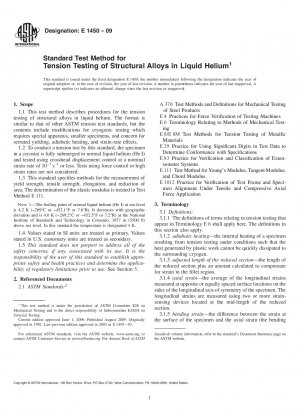ASTM E1450-09
Standard Test Method for Tension Testing of Structural Alloys in Liquid Helium
- Standard No.
- ASTM E1450-09
- Release Date
- 2009
- Published By
- American Society for Testing and Materials (ASTM)
- Status
- Replace By
- ASTM E1450-16
- Latest
- ASTM E1450-16
- Scope
Tension tests provide information on the strength and ductility of materials under uniaxial tensile stresses. This information may be useful for alloy development, comparison and selection of materials, and quality control. Under certain circumstances, the information may also be useful for design.
The force-time and force-extension records for alloys tested in liquid helium using displacement control are serrated (1). Serrations are formed by repeated bursts of unstable plastic flow and arrests. The unstable plastic flow (discontinuous yielding) is a free-running process occurring in localized regions of the reduced section at higher than nominal rates of strain with internal specimen heating. Examples of serrated stress-strain curves for a typical austenitic stainless steel with discontinuous yielding are shown in Fig. 2.
A constant specimen temperature cannot be maintained at all times during tests in liquid helium. The specimen temperature at local regions in the reduced section rises temporarily above 4 K during each discontinuous yielding event (see Fig. 2), owing to adiabatic heat. The number of events and the magnitude of the associated drops in magnitude of force are a function of the material composition and other factors such as specimen size and test speed. Typically, altering the mechanical test variables can modify but not eliminate the discontinuous yielding (2-4). Therefore, tensile property measurements of alloys in liquid helium (especially tensile strength, elongation, and reduction of area) lack the usual significance of property measurements at room temperature where deformation is more nearly isothermal and discontinuous yielding typically does not occur.
The stress-strain response of a material tested in liquid helium depends on whether force control or displacement control is used (3). Crosshead displacement control is specified in this standard since the goal is material characterization by conventional methods. The possibility of a different and less favorable material response must be taken into account when data are used for design in actual applications subject to force-controlled conditions.

FIG. 2 Typical Engineering Stress-Strain Curves and Specimen Temperature Histories, at Four Different Nominal Strain Rates,
for AISI 304L Stainless Steel Tested in Liquid Helium (4)1.1 This test method describes procedures for the tension testing of structural alloys in liquid helium. The format is similar to that of other ASTM tension test standards, but the contents include modifications for cryogenic testing which requires special apparatus, smaller specimens, and concern for serrated yielding, adiabatic heating, and strain-rate effects.
1.2 To conduct a tension test by this standard, the specimen in a cryostat is fully submerged in normal liquid helium (He I) and tested using crosshead displacement control at a nominal strain rate of 10−3 s−1 or less. Tests using force control or high strain rates are not considered.
1.3 This standard specifies methods for the measurement of yield strength, tensile strength, elongation, and reduction of area. The determination of the elastic modulus is treated in Test Method E 111
. Note 18212;The boiling point of normal liquid helium (He I) at sea level is 4.2 K (−269°C or −452.1°F or 7.6°R). It decreases wit......
ASTM E1450-09 Referenced Document
- ASTM A370 Standard Test Methods and Definitions for Mechanical Testing of Steel Products
- ASTM E1012 Standard Practice for Verification of Specimen Alignment Under Tensile Loading
- ASTM E111 Standard Test Method for Young''s Modulus, Tangent Modulus, and Chord Modulus
- ASTM E29 Standard Practice for Using Significant Digits in Test Data to Determine Conformance with Specifications
- ASTM E4 Standard Practices for Force Verification of Testing Machines
- ASTM E6 Standard Terminology Relating to Methods of Mechanical Testing
- ASTM E83 Standard Practice for Verification and Classification of Extensometer
ASTM E1450-09 history
- 2016 ASTM E1450-16 Standard Test Method for Tension Testing of Structural Alloys in Liquid Helium
- 2009 ASTM E1450-09 Standard Test Method for Tension Testing of Structural Alloys in Liquid Helium
- 2003 ASTM E1450-03 Standard Test Method for Tension Testing of Structural Alloys in Liquid Helium
- 1992 ASTM E1450-92(1998)e1 Standard Test Method for Tension Testing of Structural Alloys in Liquid Helium
- 1998 ASTM E1450-92(1998) Standard Test Method for Tension Testing of Structural Alloys in Liquid Helium
